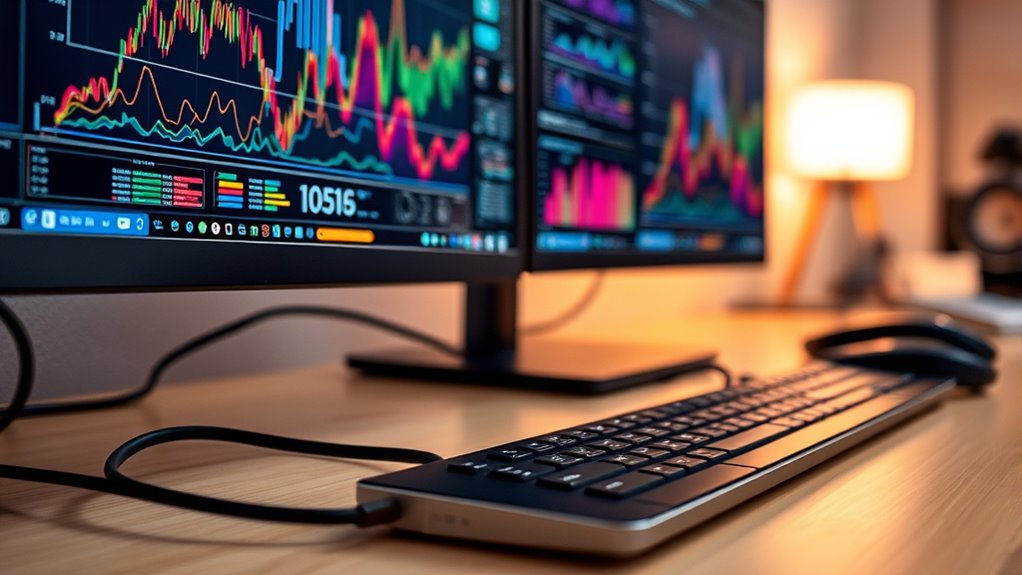To power monitors effectively, start by checking the specific power requirements and guarantee you have compatible power cords. Use available electrical outlets wisely to avoid overloads and consider surge protectors for voltage spikes. If you’re using USB-C, guarantee your devices support Power Delivery. Troubleshoot any issues by securing connections or testing outlets. Finally, optimize power management through energy-saving settings. There’s more to learn about maximizing your monitor’s performance.
Understanding Power Sources for Monitors
When setting up your monitors, understanding the various power sources is crucial for peak performance. You need to take into account the monitor specifications and how they relate to power ratings. Different monitors may require specific voltages or currents to operate efficiently. Check the manufacturer’s guidelines to verify compatibility with your power source.
Using the right power source not only maximizes performance but also prolongs the lifespan of your monitors. Keep in mind that overloading a monitor with inadequate power can lead to malfunctions or damage. By matching the monitor specifications with suitable power ratings, you can achieve maximum functionality and reliability. This awareness empowers you to maintain a seamless and effective workspace, allowing you to focus on your tasks without interruptions.
Traditional Power Options
After confirming you have the right power source, it’s important to explore traditional power options for your monitors. These options typically involve standard connections, allowing for straightforward setups in most environments. Here are some key considerations:
- Power Cords: Confirm you have the correct power cords compatible with your monitor model.
- Electrical Outlets: Identify available electrical outlets in your workspace to prevent overloading circuits.
- Surge Protectors: Use surge protectors to safeguard against voltage spikes.
- Extension Cords: If outlets are limited, consider using extension cords, but be cautious of potential power limitations.
USB-C and Power Delivery Solutions
As you consider modern power solutions, USB-C and Power Delivery (PD) technology offer a streamlined approach for powering monitors and other devices. USB-C advantages include universal compatibility, faster data transfer rates, and the ability to deliver power up to 100W. This makes it ideal for powering high-resolution monitors while reducing cable clutter. However, Power Delivery limitations should be noted; not all devices support full PD capabilities, and distance can affect performance.
| Feature | Advantages | Limitations |
|---|---|---|
| Compatibility | Works with many devices | Not universal across all models |
| Power Delivery | Up to 100W for devices | Limited by cable length |
| Data Transfer | High-speed transfer up to 40Gbps | Older devices may not support it |
| Cable Flexibility | Reversible design for ease of use | Quality varies among manufacturers |
| Port Availability | Increasingly common in new tech | Legacy ports may still be in use |
Troubleshooting Common Power Issues
Although modern power solutions like USB-C simplify connections, you might still encounter common power issues with your monitors. Here are some troubleshooting steps to take into account:
Even with USB-C’s convenience, monitor power issues can arise; consider these troubleshooting steps for a quick fix.
- Check if the power cord is securely connected to both the monitor and the wall outlet.
- Inspect the power adapter for any signs of damage or overheating.
- Ascertain the outlet is functioning by testing it with another device.
- Reset the monitor by unplugging it for a few minutes and then reconnecting it.
Tips for Optimizing Monitor Power Management
To enhance your monitor’s energy efficiency, consider adjusting its power settings. Start by accessing the monitor’s on-screen menu and locate the energy-saving options. Set the brightness to a suitable level; reducing it can greatly decrease power consumption. Utilize sleep mode settings to guarantee your monitor automatically powers down during inactivity. If your monitor supports it, enable features like Eco Mode, which can further refine energy efficiency. Regularly update your graphics drivers, as manufacturers often include enhancements for power management. Finally, consider using a power strip with an on/off switch to eliminate phantom load when the monitor isn’t in use. By fine-tuning these monitor settings, you’ll not only save energy but also prolong your monitor’s life.
Frequently Asked Questions
Can I Use a Power Bank to Power My Monitor?
Yes, you can use a power bank to power your monitor, but verify the power bank’s output matches your monitor’s wattage requirements. Check for compatibility to avoid damaging your equipment or experiencing performance issues.
What Voltage Do Most Monitors Require?
Most monitors require voltage compatibility of 12 to 24 volts, like a well-tuned engine needing the right fuel. Understanding monitor power requirements guarantees you choose the correct source, maximizing performance without risking damage.
Are There Wireless Power Options for Monitors?
Yes, there’re emerging wireless charging options utilizing energy transfer technology. These methods can eliminate cords, providing greater freedom in monitor placement. However, efficiency and compatibility are still evolving in the current market.
How Do I Know if My Monitor Is Energy Efficient?
To know if your monitor’s energy efficient, check its energy ratings and power consumption. Imagine a sailboat gliding effortlessly—similar efficiency means lower bills and a lighter environmental footprint. Look for Energy Star labels for assurance.
Can I Daisy Chain Multiple Monitors for Power?
Yes, you can daisy chain multiple monitors for power in a daisy chain setup, provided your hardware supports it. This allows for efficient power distribution, reducing cable clutter and enabling a cleaner workspace.

